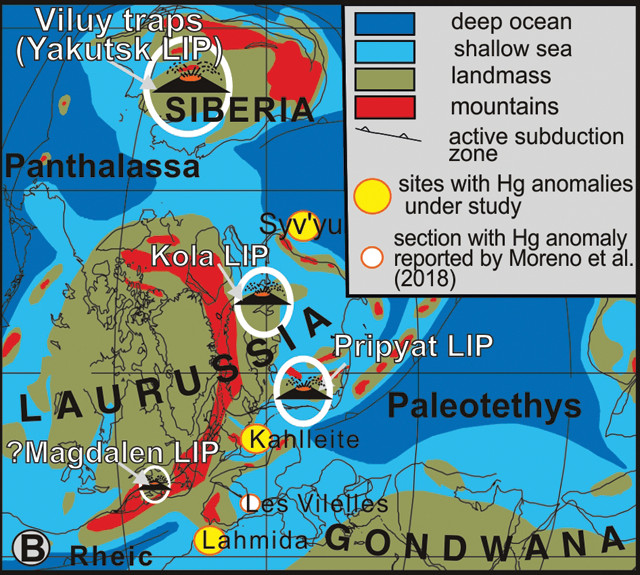
by Mary Caperton Morton Friday, August 3, 2018

The locations of sites studied for mercury abundances are shown in yellow on this plate reconstruction from the time of the Frasnian-Famennian extinction. Credit: Racki et al., Geology, April 2018.
Mercury concentration spikes in the geologic record have been linked to massive volcanism in the form of large igneous provinces (LIP) such as the Deccan Traps, a kilometers-thick heap of basalt layers that formed in what is now India beginning late in the Cretaceous, and the Siberian Traps, an even larger mass of lava that erupted in Siberia at the end of the Permian. It’s thought that vast gas emissions associated with LIP eruptions could have significantly changed climate patterns and affected conditions such as ocean acidity. And four out of five of the most devastating extinction events of the last 550 million years have previously been linked, at least partly, to the formation of LIPs. A new study looking at mercury in rocks dating to the Late Devonian has now linked the fifth to volcanism as well.
In the new work, published in Geology, researchers found evidence for a mercury anomaly in rocks from Germany, Morocco and Russia that coincides with the Frasnian-Famennian, or Late Devonian, extinction, which took place between about 376 million and 360 million years ago. This mercury spike is thought to be linked to rapid climatic perturbations brought on by cataclysmic volcanism at the Viluy LIP in Siberia.
“Our study provides the first worldwide evidence of a major phase of volcanogenic [mercury] injection into the atmosphere during the F-F mass extinction boundary, thus lending support to the postulated relationship between LIP volcanism and global crises for all of the ‘Big Five’ crises,” the team, led by Grzegorz Racki of the University of Silesia in Poland, wrote.
© 2008-2021. All rights reserved. Any copying, redistribution or retransmission of any of the contents of this service without the expressed written permission of the American Geosciences Institute is expressly prohibited. Click here for all copyright requests.